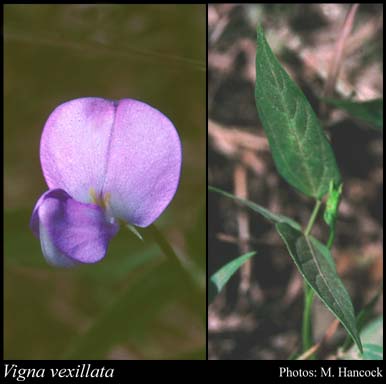- Reference
- Hist.Phys.Cuba Pl.Vasc. 440 (1846)
- Conservation Code
- Not threatened
- Naturalised Status
- Native to Western Australia
- Name Status
- Current
Prostrate or climbing perennial, herb. Fl. purple-blue, Feb to Jun. Loam. Swamps.







Scientific Description
Genus Vigna. Form twining or climbing plants. Habit herb. Stems Indumentum hairy, Pustules or glands absent, Striation (stems ribbed) not striate, Cross section terete, Spiny on any part of plant not spiny. Leaves or phylloclades Presence clearly present, Position alternate, Leaves compound, Leaves or phylloclade continuous with stem not continuous with stem, Cross section of leaf or leaflet flat with flat margins, Margins of leaf or leaflet entire, Tuberculate tubercles absent, Pustules or glands absent. Length Leaf length 55-180. Width (entire leaves only) Leaf width NaN (?). Scale leaves length mm long NaN (?). Leaflets Number three, Arrangement pinnately arranged. Terminal leaflet Presence present, Stalk stalked. Indumentum Presence hairy, Type simple. Stipules Presence present and persistent to older leaves, Glands without glands, Ribs ribless. Length Stipule length 3-4. Bracteoles Presence present but early deciduous, Indumentum hairy (?) or glabrous (?), Striation striate (?) or not striate (?). Length Bracteole length NaN (?). Pedicel Presence present (?) or absent (flowers sessile) (?), Indumentum hairy (?) or glabrous (?). Length Pedicel length NaN (?). Calyx Pustules or glands absent, Ribs ribbed, Enlarged in fruit not accrescent. Length Calyx length 11. Indumentum Presence hairy, Type with simple hairs. Corolla Colour patterning multicoloured, Colour (when multicoloured - choose one colour) purple or blue, Colour (when multicoloured - choose a second colour) purple or blue, Petal claws ( the narrow base of the petals present. Length Corolla length 18.5-20. Indumentum Presence absent. Standard Indumentum glabrous, Auricles not auriculate. Length Standard length 17. Wings Auricles auriculate (?) or not auriculate (?). Length Wing length NaN (?). Keel Auricles auriculate (?) or not auriculate (?), Indumentum hairy at least in part (?) or glabrous (?), Beak beaked (?) or not beaked (?). Length Keel length NaN (?). Stamens Number ten. Anthers anther length NaN (?), Position all at the same level (filaments all the same loength) (?) or at two different levels (filaments alternately long and short) (?). Filaments Fusion free (or united at the very base) (?), united in an open sheath (?), united in a closed sheath (?) or united in an open sheath with one free stamen (?). Length Filament length NaN (?). Ovary Placement stipitate (?) or sessile or subsessile (?). Indumentum Presence hairy or glandular (?) or glabrous (?). Style Indumentum hairy or glandular towards the base (?) or glabrous (?), Bearded ( with a tuft of hairs at apex ) bearded (with a tuft of hairs at apex) (?) or not bearded (?), Apex terete (?) or flattened at apex (?). Length Style length NaN (?). Fruit Type dehiscent (a pod or follicle), Constriction constricted between the seeds, Compression flat or compressed, Placement stipitate, Beak not beaked. Length Fruit length 95-100. Width Fruit width 3-5. Indumentum Presence hairy, Indumentum type with simple hairs. Flowering time February, March, April or December. Distribution IBRA Bioregion Northern Kimberley or Dampierland.
Distribution
- IBRA Regions
- Dampierland, Northern Kimberley.
- IBRA Subregions
- Mitchell, Pindanland.
- IMCRA Regions
- Kimberley.
- Local Government Areas (LGAs)
- Broome, Derby-West Kimberley, Wyndham-East Kimberley.